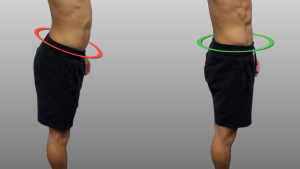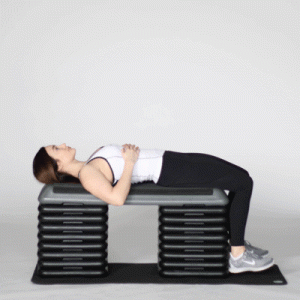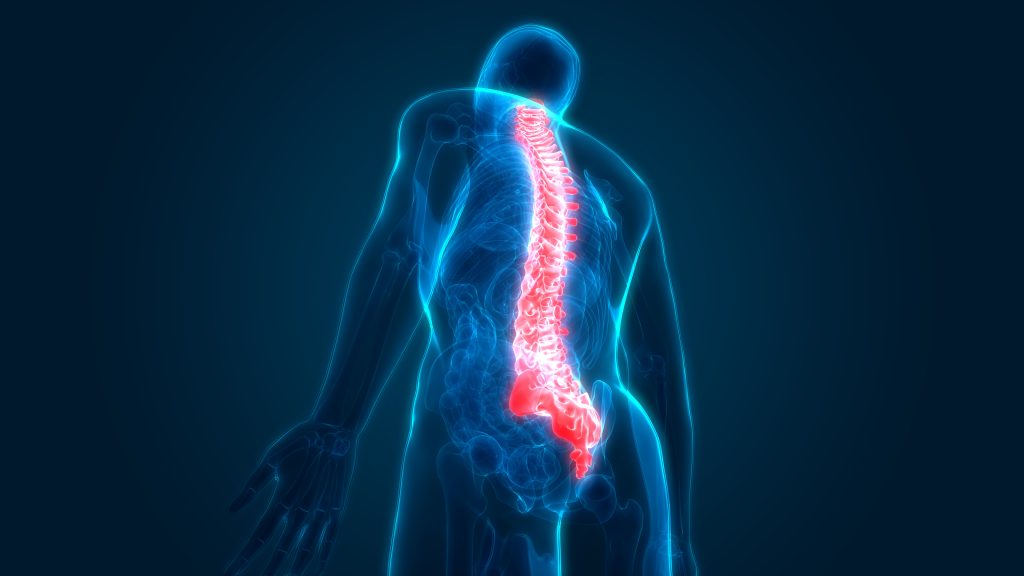A slight tilt in the lower back and pelvis is normal. But if you’re bothered by pain, bad posture, or weak muscles in certain areas, you might have hyperlordosis. This article covers what it is and how to spot it. We then go over how to fix hyperlordosis.
What is Hyperlordosis?
Hyperlordosis refers to the tilting forward of the pelvis. This causes a rounding of the lower spine. To an extent, this is normal. One study showed that the majority of people had between a 12 to 13-degree anterior pelvic tilt. But an excessively pronounced tilt, termed hyperlordosis, can cause many issues.

Symptoms of Hyperlordosis
If you’re trying to find out how to fix hyperlordosis, you will probably have experienced one or more of these symptoms:
- Tight hip flexors
- Lower back pain
- Inwardly rotated knees
- Weak glute muscles
- Hip and knee pain
- Pronated tummy
- Weak abdominals
- Postural imbalances
Test for Hyperlordosis
If you recognise some of the above symptoms, it might be worth checking for sure before you begin to fix hyperlordosis. Ginta (2017) describes a simple test you can take. This is called the Thomas Test, and all you need is a table:
- Sit on the edge of the table
- Lie backward, and hang your legs off the table at the knee. The knee should be bent at a 45-degree angle with your feet dangling off the edge of the table.
- Gently pull one leg toward your chest, using your hands clasped under your knee.
- Lower this leg, and then repeat with the other.

If you have a normal pelvis, the rear of the relaxed leg will be touching the table when you are in the positions described above. However, pulling one leg to the chest might mean your resting leg needs to extend. You might also find you need to rotate the hip or leg to reach this position. If you experience any of these difficulties, you likely have hyperlordosis.
Causes of Hyperlordosis
Before we look at how to fix hyperlordosis, let’s first look at where it comes from. Dr. Alan Mandell, chiropractor and founder of MotivationalDoc.com, points out that the entire posterior chain can be involved in hyperlordosis. Also, he highlights that symptoms and causes can interact.
Mandell (2016) explains that hyperlordosis is often caused by excessive sitting. This is common in our society due to most people being sat at a desk, a computer, or in a car for the most part of the day. Sitting for prolonged periods like this causes the hip flexors to contract, and also creates forward head posture – when the neck and head tilt forward. This can, in turn,, contribute to hyperlordosis. Other postural causes include fallen arches or pronated feet.

As well as being due to posture and muscle imbalances, hyperlordosis can also be down to variations in bone structure. A study by the University of Manchester found that there was a lot of difference in pelvic shape when comparing 30 medical cadavers. The degree of pelvic tilt in these cadavers ranged from 0 to 23 degrees (Preece et al., 2008).
How to Fix Hyperlordosis
While we cannot change our bone structure to fix hyperlordosis, we can do things to improve posture and muscle imbalances. We can do this in a variety of ways.
-
Take Breaks from Extended Sitting
It’s sometimes unavoidable to have to sit for prolonged periods. However, regularly getting up and stretching can help fix hyperlordosis. If you drive a lot, make stops and ensure you stretch your legs when you do so. If you have an office job, regularly taking 5 minutes to walk around the office can help.
-
Stretch the Hip Flexors
Tightness in the hip flexors causes hyperlordosis, and can also perpetuate it. To fix hyperlordosis, incorporate hip flexor stretches into your daily routine. A half kneeling hip flexor stretch helps relax tightness and improve hip flexibility.
First, perform a lunge, and rest your back knee on the ground. The left leg should be at a 90-degree angle at the knee, with the foot flat on the ground. Contract your glute and ab muscles to bring your pelvis forward. Then, bend the front knee to lean forward until you feel tension in the hip flexor of the back leg. Hold for 30 seconds, keeping the pelvis tilted inwards through the whole stretch, then release. Repeat this up to 5 times, then swap legs.
-
Increase Strength in the Posterior Chain.
Hyperlordosis is associated with weak abdominal and glute muscles. If you have hyperlordosis, the lower back takes most of the work in supporting your posture. As a result, the abs and glutes weaken further. To help fix hyperlordosis, you can negate this by strengthening your glutes and abs. Below are some of our Shredify athletes demonstrating simple and practical exercises.
Glute Strengthening Exercises
Some simple exercises targeting the glutes include:
Glute Extensions
Start on all fours, on the floor. Bring one knee up to your chest, then extend the leg backward, contracting the glute muscle. Repeat for as long as you can, then swap legs.
Hip Thrusts
Lie on your back on the floor with your knees bent and hips flat. If using a weight, hold it in your hips just below the abdominals. Contract your glutes and lift your hips until your thighs are in line with your torso. Lower the hips and repeat.
Ab Strengthening Exercises
Some effective abdominal exercises that need no equipment include:
Crunches
Start lying on your back, with your knees bent. Place your fingers next to your temples. Contract your abdominals and lift your chest up off the ground. Your elbows should face towards your knees. Lower yourself back down and repeat.
Plank
Position yourself horizontally on the floor, face down. Your body weight should be rested on your toes and forearms. Keep your back straight, and tuck your chin. Hold this for as long as you can.
-
Check Your Form In the Gym
Fitness author Michael Matthews (https://www.muscleforlife.com/about-me/) points out that hyperlordosis is worsened with poor form. In particular, you should pay attention to your back when squatting, hip thrusting, and deadlifting. When performing these movements, it is crucial not to hyperextend the back.
If you notice this happening when you exercise, Matthews says this can be due to lack of mobility. To help fix hyperlordosis in these exercises, perform some mobility drills before you begin your workout. If you like to lift heavy, you could also consider a lifting belt to help support the lower back.
How to Fix Hyperlordosis: A Summary
While a degree of anterior pelvic tilt is normal, hyperlordosis can cause many issues. Hyperlordosis affects the entire posterior chain, so many causes and symptoms can interact. Exercises that strengthen the abdominals and glute muscles can help fix hyperlordosis. Also, make sure you aren’t sitting for extended periods. Alongside this, hip flexor stretches help to open the hips. Ensuring good form when you do squats, deadlifts and hip thrusts can prevent hyperlordosis from worsening and decreases the chance of injury. If you suspect fallen arches are contributing, book an appointment with the GP.
Now you know about the exercises that can help with hyperlordosis, why not build them into a workout plan. Read about how to find the perfect workout plan here.
